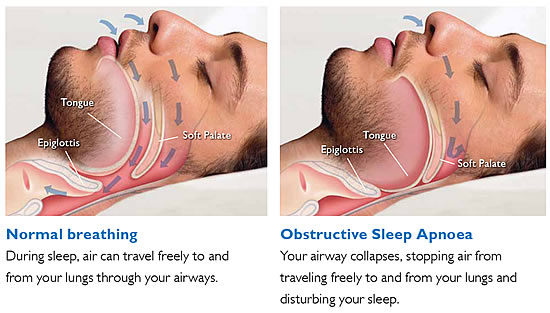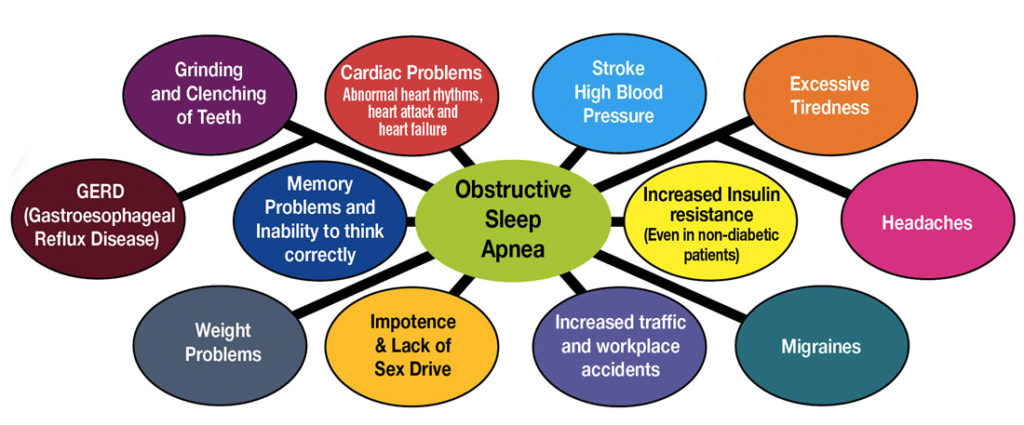What Is Sleep Apnea?

Sleep Apnea Symptoms
Sleep Apnea Causes
A multitude of symptoms affect patients dealing with this disorder, including:
- Loud snoring
- Chronic fatigue, though patients are sleeping sufficiently.
- Insomnia and sleep deprivation
- Loud breathing
- The constant need to breathe through the mouth, due to the lack of oxygen being received through the nose.
- Dry mouth and throat
- Depression and mood swings, due to the profound lack of sleep.
- Weight gain that results from elevated cortisol levels, which are responsible for stress and maintaining sleeping patterns.
- Headaches
- Being unable to breathe
Like all conditions, however, patients can experience all of these sleep apnea symptoms, while some experience very few of them. In order to better understand the severity of the signs, professionals must establish the causes before making an overall diagnosis and course of treatment.

Sleep Apnea Causes
Men are more likely to contract this disorder than women, but females are not exempt from contracting it at all. Risk factors, like age and obesity, vastly contribute to the disorder. Other sleep apnea causes include:
- Genetics
- Those developing the condition, hypertension, are said to demonstrate symptoms of sleep apnea, too.
- Cardiovascular problems
- Those who have a history of strokes
A common form of this condition, known as obstructive sleep apnea (OSA), results when there is an obstruction of the airway. This ultimately instigates a lack of oxygen being present in the blood, which fuels the common symptoms of the disorder. OSA is responsible for the choking and gasping for breath signs affiliated with the condition as well. Though sleep apnea causes and symptoms are widely known and studied, this remains a condition that stumps physicians each day, overall.
Sleep Apnea Treatment: How Is It Diagnosed?
As previously mentioned, this disorder is not immediately treated–especially since patients do not know how to communicate their symptoms. In fact, people who are first demonstrating these signs confuse the issue with mental disorders, like anxiety or depression. Of course, patients experience their symptoms slowly before they prove to be life-threatening. These factors result in the prominent need for dentists to diagnose this problem.
The majority of Americans visit the dentist at least once a year. Given that this condition is incredibly common (it affects one in fifteen Americans, as previously mentioned), the ratio between visits and patients with this disorder works in favor of treating the condition entirely. Dentists, of course, deal with the oral region of patients. This gives professionals the perfect view to distinguish any airway obstructions and abnormalities, like those demonstrated through OSA.
Surely some patients demonstrate other symptoms that could penultimately result in the diagnosis of sleep apnea, including:
- Slender or narrow maxillary and mandibular arches.
- Being unable to see the visible portion of the cavity behind the nose and mouth. This is the portion that connects the throat to the esophagus.
- A long, soft palette that hangs below the tongue.
- A crenelated, or pie crust tongue, that demonstrates a border like pattern as a result of the restrictive pressure being applied to it.
- A deviated septum
- Mouth breathing during a head-forward posture position.
- A large neck–especially in terms of circumference.
Dentists who remain aware of these symptoms are able to not only diagnose the condition, but are able to determine a sleep apnea treatment plan by using Oral Appliance Therapy, which uses hardware reminiscent of a mouthguard directed for patients to wear while they sleep. This appliance supports a jaw in a manner that promotes an open airway, which helps abate the severity of the disorder and improves oral health, overall.
